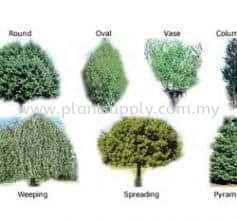Shade Trees Selection

View Full Size
Trees add a lot to the home landscape.
Planting in the right location and practising proper tree maintenance such as pruning and watering is critical to the tree’s health.
A shade tree is an investment in your home’s future and in the environment. A misplaced tree is doomed to a stressful and perhaps short life. A tree that outgrows its space can damage and endanger nearby structures. No matter what type of shade tree you choose, you need to consider the following:
Here’s some advice on choosing, planting and caring for shade trees.
Benefits of Shade Trees

Choosing Shade Tree Location

Shade Tree Consideration


Planting in the right location and practising proper tree maintenance such as pruning and watering is critical to the tree’s health.
A shade tree is an investment in your home’s future and in the environment. A misplaced tree is doomed to a stressful and perhaps short life. A tree that outgrows its space can damage and endanger nearby structures. No matter what type of shade tree you choose, you need to consider the following:
Here’s some advice on choosing, planting and caring for shade trees.
Benefits of Shade Trees
- Reduce heating and cooling costs both indoors and out.
- Drop the temperature during the hot season.
- Reduce heat reflected from paved areas.
- Attract and sustain wildlife.
- Convert CO2 to O2
- Help prevent soil erosion.
- Increase your property value.
- Provide leaves for the compost.

Choosing Shade Tree Location
- Soil – Do a soil test and follow the recommendations. Urban areas often have shallow or compacted topsoil that needs amending.
- Sun – How much sunlight does the site get? Most shade trees prefer full to partial sun. Check the plant tag for sunlight requirements.
- Wind – Strong prevailing winds dry out the tree and the soil. Trees with dense foliage can be toppled by severe storms.
- Space – How much space do you have? Plan for the tree’s size at maturity. The mature height and width should be on the plant tag. You can also check a plant guide for these key measurements. Remember the space needed for proper root growth. A tree’s roots can grow up to 3 times the diameter of the canopy. Consider your neighbours when choosing and planting – they might not enjoy raking leaves as much as you do. Don’t plant a shade tree too close to other trees. They’ll compete for water and nutrients and none of them will thrive.
- Utilities – If you have wires overhead, your tree can only reach a maximum of 20 feet in height (maybe less) before interfering with utilities

Shade Tree Consideration
- Maintenance
- Healthy shade trees require little maintenance other than occasional pruning and feeding. And of course, there’s the raking. A mature tree can produce a lot of leaves. Make sure you’re up to the challenge. Also keep in mind how you’ll be mowing around the tree. Unless you enjoy whacking your head every time you pass underneath it on a riding mower, look for a tree without low-hanging branches.
- Appearance
- Trees will mature into distinctive shapes. Make sure the tree fits the overall design of your landscape.
- Planting
- All of your thought and research when selecting a tree is worthless if it doesn’t grow. Make sure that you plant the tree correctly and get it off to a good start.
- Pruning and Trimming
- Lower branches help support the tree and trunk and provide balance. Cut sparingly or consult an expert before pruning anything other than dead wood. Don’t top trees – if your tree has overgrown its bounds there are alternatives to giving it a flat top. Crown reduction is a technique that allows the tree mass to be reduced without changing its natural shape or endangering its health. Again, consult an expert about these techniques.
- Trimming Around Trunks
- Avoid string trimmers unless you have a very steady hand. Even small wounds to the outer bark allow insects and disease inside. When the bark is stripped from around the trunk (called girdling), the tree eventually will die.
- Grass underneath
- sometimes trimming underneath a large shade tree is a non-issue since very often no grass will grow there anyway. The fact is, maintaining turfgrass under shade trees can be a challenge. When grass and trees compete for water, nutrients and sunlight, usually the trees win. If you insist on grass, there are shade-tolerant grass varieties available. The alternative is to make the area under the tree a turf-free area. Mulch 2-4 inches deep (more than 6 inches is too deep – water and air won’t get through). Keep the mulch 1-2 inches away from the trunk.
- Feeding and Watering
- Healthy trees generally don’t require much fertilizing. If you notice reduced growth, give them a feeding. Provide water regularly, but only if you’re able to water the tree deeply. Remember that a tree’s roots are normally in the top 6-12 inches of soil and any water or chemical (fertilizer or pesticide) will be absorbed by the tree.



